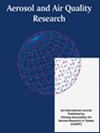泰国清迈雾霾季节和非雾霾季节PM2.5氧化电位的来源
IF 2.5
4区 环境科学与生态学
Q3 ENVIRONMENTAL SCIENCES
引用次数: 0
摘要
本文章由计算机程序翻译,如有差异,请以英文原文为准。
Sources of PM2.5 Oxidative Potential during Haze and Non-haze Seasons in Chiang Mai, Thailand
Dithiothreitol (DTT) assay is an acellular technique used to investigate the oxidative potential (OP) of chemical substances bound on PM, which may potentially lead to oxidative stress after exposure. In this study, the source contributions of 16 high priority polycyclic aromatic hydrocarbons (PAHs), designated by the United States Environmental Protection Agency (U.S. EPA), and 10 species of water-soluble inorganic ions bound on PM 2.5 and their OP were investigated using DTT assay. The 24-hr ambient PM 2.5 samples were collected throughout 2018–2019 and the analyzed OP was compared during haze episodes, which generally occurs in the dry season, and non-haze rainy season in the Chiang Mai-Lamphun basin. During haze episodes, DTTv activity was positively correlated with 4–5 rings PAHs including fluoranthene (Fla) pyrene (Pyr), benzo[a]anthracene (BaA), chrysene (Chr), benzo[b]fluoranthene (BbF) and benzo[k]fluoranthene (BkF) with coefficient ranging from 0.327 to 0.545, p = 0.002 to 0.009 (Pearson’s correlation). Inorganic ions, particularly NH 4+ , SO 42– , and NO 3– , which are the tracers of secondary inorganic aerosol (SIA), were positively correlated with DTTv activity (r = 0.394 to 0.659. p = 0.000 to 0.047; Spearman’s correlation). Positive matrix factorization (PMF) indicated the biomass burning factor had the highest contribution (57.9%) to PM 2.5 during haze episodes, followed by SIA (26.2%), and vehicle exhausts (7.8%). Furthermore, multiple linear regression (MLR) showed that biomass burning was the highest contributor to DTTv (43.0%). These results suggest that during haze episodes, higher levels of PM 2.5 and its chemical compositions play a crucial role on OP, particularly DTTv activity, which may induce oxidative stress in human body.
求助全文
通过发布文献求助,成功后即可免费获取论文全文。
去求助
来源期刊

Aerosol and Air Quality Research
ENVIRONMENTAL SCIENCES-
CiteScore
8.30
自引率
10.00%
发文量
163
审稿时长
3 months
期刊介绍:
The international journal of Aerosol and Air Quality Research (AAQR) covers all aspects of aerosol science and technology, atmospheric science and air quality related issues. It encompasses a multi-disciplinary field, including:
- Aerosol, air quality, atmospheric chemistry and global change;
- Air toxics (hazardous air pollutants (HAPs), persistent organic pollutants (POPs)) - Sources, control, transport and fate, human exposure;
- Nanoparticle and nanotechnology;
- Sources, combustion, thermal decomposition, emission, properties, behavior, formation, transport, deposition, measurement and analysis;
- Effects on the environments;
- Air quality and human health;
- Bioaerosols;
- Indoor air quality;
- Energy and air pollution;
- Pollution control technologies;
- Invention and improvement of sampling instruments and technologies;
- Optical/radiative properties and remote sensing;
- Carbon dioxide emission, capture, storage and utilization; novel methods for the reduction of carbon dioxide emission;
- Other topics related to aerosol and air quality.
 求助内容:
求助内容: 应助结果提醒方式:
应助结果提醒方式:


